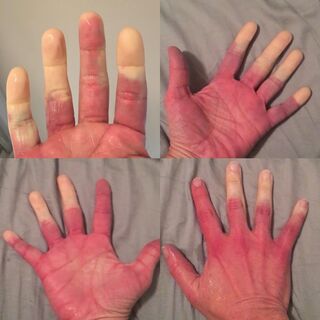Mania
Inside My Manic Mind: Sex, Lies, and Catecholamines
Personal Perspective: Notes and art from a neuroscientist's manic episodes.
Posted July 20, 2022 Reviewed by Gary Drevitch
Key points
- Levels of the catecholamines dopamine, norepinephrine, and adrenaline tend to surge during a manic episode.
- Spiking norepinephrine levels may be critical in the switch to a manic episode.
- Hypersexuality has been linked to increased dopamine levels in the brain circuits involved in pleasure and decision-making.
- Adrenaline rushes are involved in the sharpened senses and boost of energy associated with mania.
It was the early 2000s, and I was in San Francisco for a conference. Earlier in the day, a panel presentation I had organized and chaired, which included a sitting member of Congress, had gone off without a hitch. And now the night was mine.
I didn't know about my bipolar disorder at the time. But the energy and drive that helped me juggle the presentation with all of my other work and family responsibilities were also fueling risky behaviors and poor decisions.
I turned onto a block in a part of the city I had been warned to steer clear of. As the figures milling around on the street became aware of me, they all scattered. All but one who stood there rooted to the sidewalk. As I approached, she looked me up and down and took a long draw on her cigarette. "Evening, officer," she smirked.
I got better at it, unfortunately. For years, I led a secret life of affairs, prostitutes, and Craigslist/AdultFriendFinder hook-ups. Sometimes I would feel so guilty that I would stop, only to resume a few years later. I eventually deluded myself into believing that my ex-wife had to know what was going on, and so she was giving her tacit approval. By the time she found out, I was seeing four women, chatting up a fifth, and had the audacity to ask, "Can't I just keep one?"
Catecholamines and mania
Dopamine, epinephrine (aka adrenaline), and norepinephrine (aka noradrenaline) are physiologically active molecules known as catecholamines. Catecholamines act both as neurotransmitters and hormones and are directly involved in the "fight, flight, or freeze" response of the sympathetic nervous system. Their levels surge during a manic episode.
Spiking norepinephrine levels from a cluster of neurons in the brainstem called the locus coeruleus may be critical in the switch to a manic episode, and symptoms of mania such as hypersexuality have been linked to increased dopamine levels in brain circuits involved in how we experience pleasure and make decisions. Adrenaline rushes occur when we're excited, afraid, or otherwise emotionally charged and are involved in the sharpened senses and boost of energy associated with mania.

During my last and most severe manic episode, I still had not been diagnosed with bipolar disorder. I was trying to reconcile the symptoms I was experiencing with the medications I was taking at the time for depression and anxiety. Through the fog of mania, I recognized that I was getting a double dose of extra norepinephrine (bupropion plus desvenlafaxine), and I was trying to reconcile that with the feeling that my body was stuck with its adrenaline faucet wide open.
Figure 1 shows some of my notes from that period. I felt like there was something going on with my catecholamine levels and was curious about how catecholamine biosynthetic pathways connected to adrenaline/epinephrine levels (top and bottom right). I also noted changes in my pupillary response that seemed consistent with high levels of adrenaline fueling my bodily functions like gasoline (bottom left):

Resting eyes. Snap to focus. Irises narrow like an industrial machine that runs on gasoline... maybe it does. Adrenaline? Natural and not?
In addition to making you energetic and alert, adrenaline helps fat cells release energy and increases metabolism. Although my activity levels increased significantly during that manic episode, it also felt like the pounds were dropping off faster than I expected, particularly in spite of my near-constant cooking and eating. Figure 2 shows me in January (left) and December (right) of the same year. I've struggled with my weight ever since I was a child, and looking back over the years, I now see how my cycles through mania and depression have affected regular body weight swings of up to 100 pounds.

Another sign pointing to out-of-whack norepinephrine levels was that I experienced recurrent decreased blood flow in my fingers, known as Raynaud's phenomenon (Figure 3).
Raynaud's can occur due to cold sensitivity, which I also experienced, and has been linked to abnormally high levels of norepinephrine. The effect was so prominent that I once had someone at the gym ask if I was OK when they saw me rubbing my pallid fingers shortly into a workout.
I also experienced what I recognized as "flow," a state of full task engagement and low levels of self-referential thinking. Flow is often associated with athletes and artists who achieve peak performance by becoming fully absorbed in a task. The experience is accompanied by a sense of accomplishment, meaningfulness, and positive mood states and has been associated with increased activity of norepinephrine and dopamine neurocircuitry.

In Figure 4, my notes are from the period after I was diagnosed with bipolar disorder and had started taking antipsychotic medication. I had also been self-medicating with cannabis products. I wrote, "Is flow mania? If you have tendencies, is THC a trigger?"
Finding the right balance
As I mentioned, the medications I was taking when I had my most severe manic episode were giving me a double dose of extra norepinephrine, along with enhanced dopamine and serotonin. I responded quickly to antipsychotic medications but swung into an intractable depression.
My psychiatrists steered clear of the antidepressants I had been on before since they likely contributed to my mania. However, after an excruciatingly slow period of trial and error, we discovered that the only combination that alleviated my depression was the same combination that sparked my mania, only with lithium added to the mix. In fact, that sort of balancing act, in which antidepressants that augment norepinephrine are prescribed in combination with an antimanic agent such as lithium, has been advanced as a treatment protocol for those like me who need to walk a tightrope between extremes of catecholamine dysfunction.
References
Ashok, A. H., Marques, T. R., Jauhar, S., Nour, M. M., Goodwin, G. M., Young, A. H., & Howes, O. D. (2017). The dopamine hypothesis of bipolar affective disorder: the state of the art and implications for treatment. Molecular Psychiatry, 22(5):666–679. https://doi.org/10.1038/mp.2017.16
Kurita M. (2016). Noradrenaline plays a critical role in the switch to a manic episode and treatment of a depressive episode. Neuropsychiatric Disease and Treatment, 12:2373–2380. https://doi.org/10.2147/NDT.S109835
van Enkhuizen, J., Janowsky, D. S., Olivier, B., Minassian, A., Perry, W., Young, J. W., & Geyer, M. A. (2015). The catecholaminergic-cholinergic balance hypothesis of bipolar disorder revisited. European Journal of Pharmacology, 753:114–126. https://doi.org/10.1016/j.ejphar.2014.05.063




